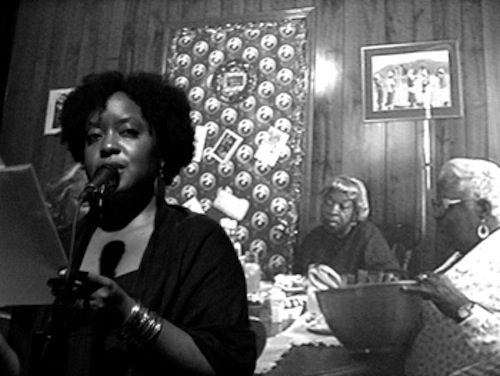The Audience is Present (Part III)

“Who’s this our? Can I bring my mother?”
—Tonya Foster
I’ve been thinking, obviously, about audience—more particularly, about the relationship between the artist and his or her audience. Part of what motivated me to write on this subject (see Part I and Part II) is the fact that I regularly read or hear poets (and other writers/artists) constructing a relationship of indifference or antagonism between themselves and their audiences. Sometimes this tension is framed as a negative pressure that audience places on the poet in the process of creation. In this context, thinking about audience is okay after the work has been produced, but not while it is in progress, when thoughts of audience apparently serve only to constrain creation. What if they don’t like this? becomes a question that leads the poet to write things that are “safe,” that conform to the poet’s idea of what her audience wants to read or hear.
I certainly understand and relate to this fear! But rather than banish audience from the scene of creation, we might do better to expand our ways of thinking about the people who do or may engage with our work. Who do we think of when we think of audience? The “average” poetry reader? The judges of contests? The circle(s) of poets we most often come in contact with (in person, on the page, on the screen)? Our friends and families? University undergrads? People with whom we share a culture? People of the same sexual orientation? People who shop where we shop? If one audience seems unlikely to be sympathetic to the work, maybe the thing to do is imagine another audience that would appreciate it. If this is a different audience than those we usually engage, so be it. We are all allowed to grow and experiment with different things. Remembering that there is not just one audience, but several (ideal, actual, and potential), can be liberating. I particularly love Harryette Mullen’s evocation of the “unborn reader” whom she imagines coming upon her work at some future time. What might one’s unborn audience be interested in? Why assume that future audiences will have the same expectations, biases, or proclivities as the audiences of today?
Better yet: why assume that most audiences of today will not be interested in anything but the most conventional poetry? And why assume that anything that appeals to audience A will by definition be of no interest to audience B? Another reason some give for ignoring audience is that succumbing to the pressure (or desire) to make one’s work “accessible” leads to work that is too “easy.” Well, here’s a challenge for fans of the difficult: try to write a poem that might appeal to—or at least invite—a broad, non-specialist audience and that satisfies one’s own aesthetic impulses as well. Or, to take a different kind of boundary: try to write a poem that will amuse the insiders to the scene or culture or tradition you want to engage and offer a point of entry and entertainment to audiences without the insider knowledge held by your ideal readers. (Poetry for Tonya Foster and Tonya Foster’s mother, to draw upon my epigraph.*) That kind of difficulty can give writers the pleasure of creative transgression and readers the delightful surprise of recognizing themselves in works they perhaps thought they’d be excluded from.
Audiences are harder to ignore in live performance. Harder—but not impossible. In a sense, Cathy Park Hong’s stand-up proposition points toward that unhappy possibility and urges us to avoid it at all costs. When a group of people gathers to hear poetry, and nothing happens that startles, confounds, or fascinates them, it is a lost opportunity for the audience and the poet alike. Humor can create these effects—not polite humor, but the disarming, unnerving sort, as Cathy noted. When the audience expects words and encounters song, things can shift; when they expect to use their ears and find their eyes just as much engaged, a space opens up. The poet, too, should court surprise. Test-driving a poem still warm from one’s printer before a live audience can generate wonderful feedback—explicit or intuited—to take back into the revision process. And old poems can become new again when we present them in fresh or even unanticipated contexts. Live audiences are just that: alive. The energy we put into respecting them, in all their unpredictable diversity and complexity, comes back to us and feeds our work—or it can. This understanding about live audiences can continue to inform our relationship to audience even when we are working in solitude. Whether distant, unlikely, or unborn, the audience is always present, if we want it to be.
* The lines quoted as my epigraph appear in the Delirious Hem blog post linked above, in the section labeled "Tonya's #4."
Born and raised in Nashville, Tennessee, poet Evie Shockley earned a BA at Northwestern University, ...
Read Full Biography

